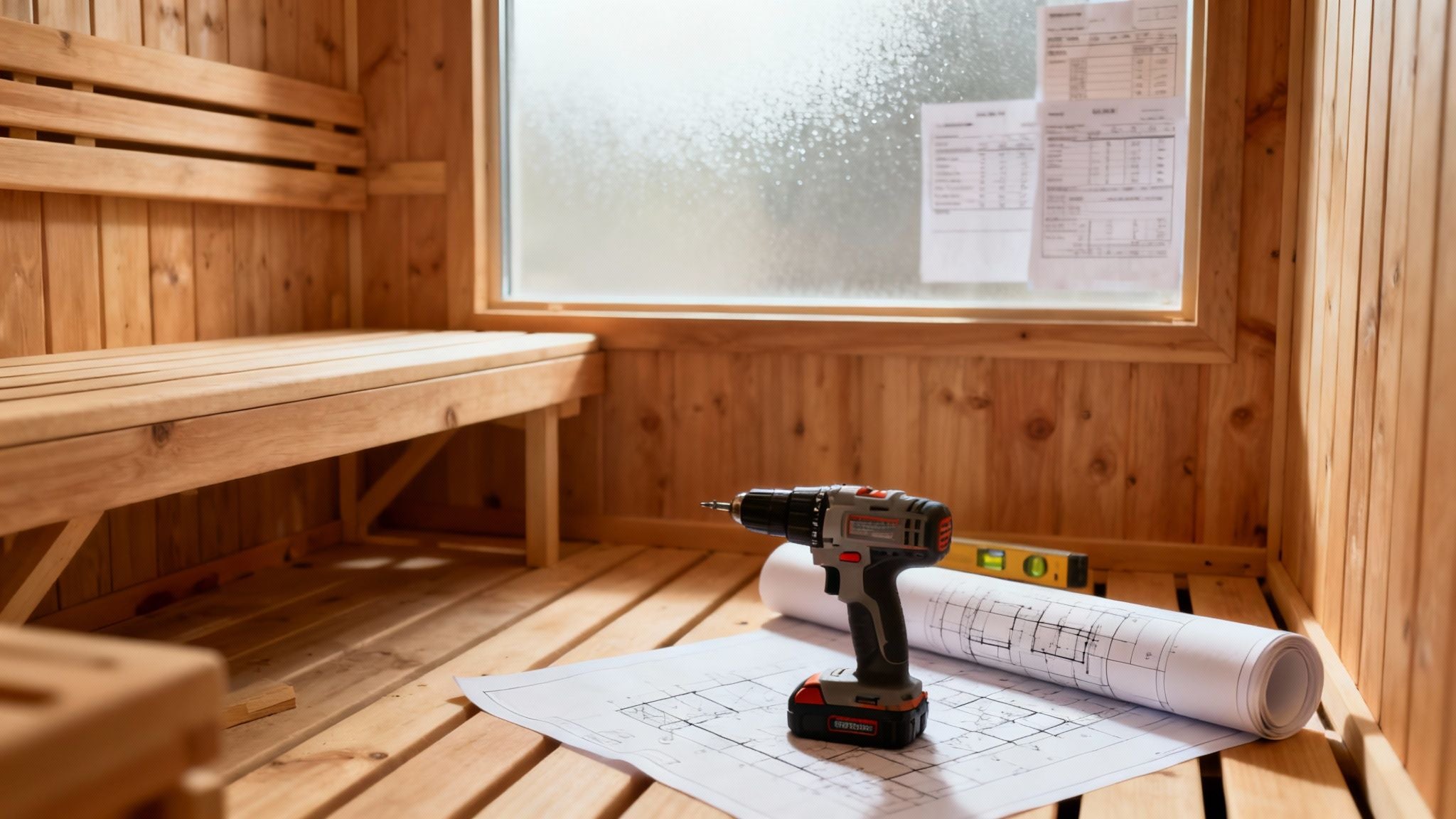
Cost of Installing a Sauna: Complete Guide & Tips
So, you're thinking about bringing the bliss of a sauna into your home? It's a fantastic move for your health and relaxation, but the first question on everyone's mind is always: "What's this actually going to cost me?"
The short answer is that a home sauna installation can run anywhere from $2,000 for a straightforward DIY kit to over $20,000 for a fully custom, professionally built oasis. That's a huge range, I know. The final number depends on a lot more than just the price of the sauna unit itself. You've also got to factor in labor, preparing the site, and any necessary electrical work.
Breaking Down Home Sauna Costs
Getting a handle on the total investment for a home sauna is a bit like planning a kitchen remodel. You can go for simple, off-the-shelf cabinets and do the work yourself, or you can hire a designer for a completely custom layout with high-end appliances. Saunas are no different. You'll find everything from affordable DIY kits to luxurious, spa-like sanctuaries installed by seasoned pros.
Every choice you make along the way—from the type of wood to the heater style—will nudge the final price tag up or down.
To give you a clearer picture, here’s a visual breakdown of what you can generally expect to spend on different types of home saunas.
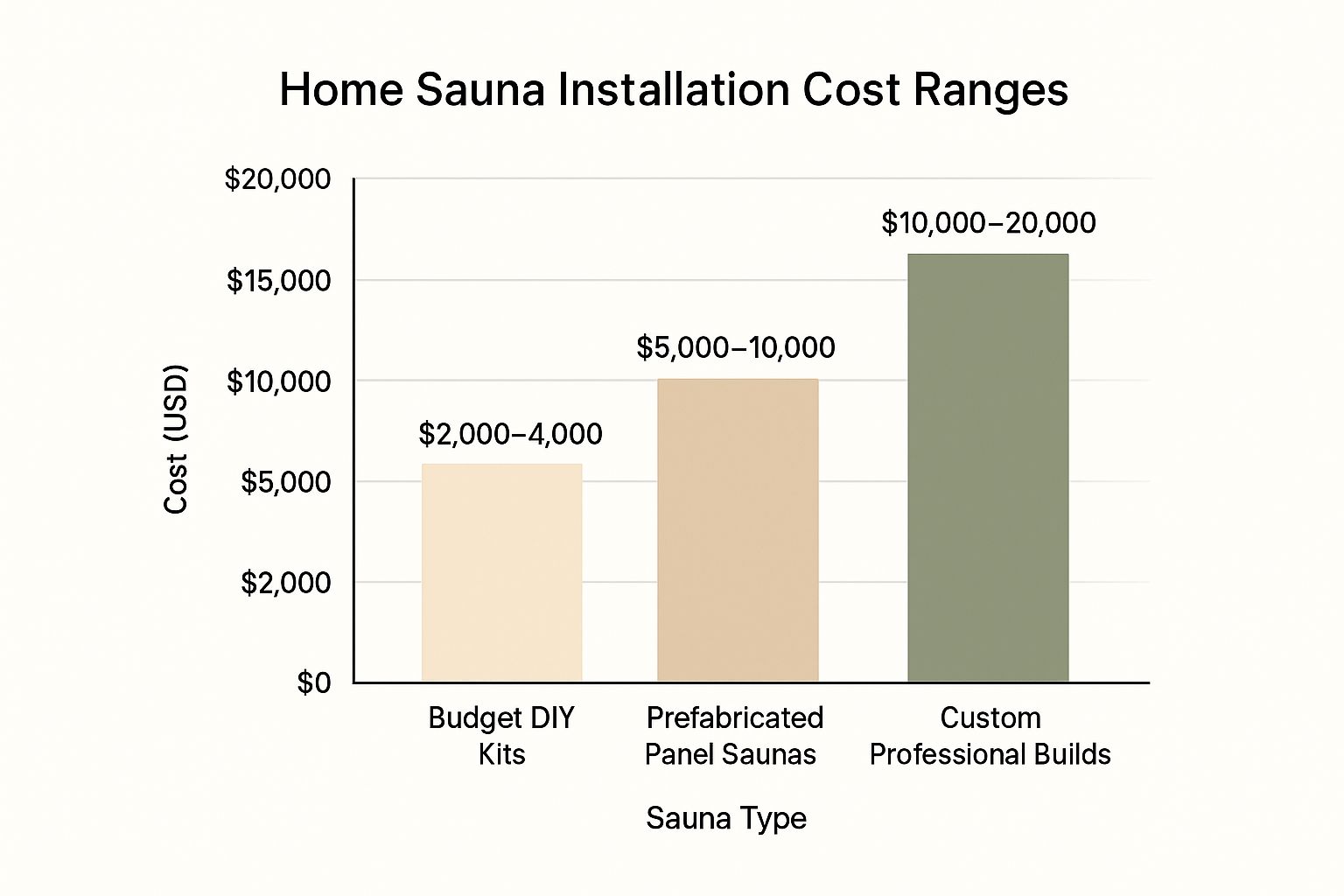
As you can see, the leap from a simple DIY kit to a custom-built sauna is significant. That difference comes down to the quality of materials, the size of the unit, and the complexity of the labor involved.
To help you budget, here’s a quick table summarizing the typical all-in costs for various sauna types.
Estimated Sauna Installation Costs by Type
| Sauna Type | Average Unit Cost | Estimated Installation Cost | Total Estimated Cost |
|---|---|---|---|
| Prefab Infrared Kit | $1,500 - $6,000 | $300 - $800 | $1,800 - $6,800 |
| Prefab Traditional Kit | $3,000 - $8,000 | $500 - $1,500 | $3,500 - $9,500 |
| Outdoor Barrel Sauna | $4,000 - $9,000 | $700 - $2,000 | $4,700 - $11,000 |
| Custom-Built Sauna | $7,000 - $15,000+ | $2,000 - $5,000+ | $9,000 - $20,000+ |
This table illustrates how the total cost is a combination of the unit itself and the labor needed to get it up and running safely.
A Closer Look at the Numbers
So, what's behind these costs? For a traditional sauna, hiring a professional for the installation—which often involves some light construction and hooking up the heater—will typically add $1,000 to $3,000 to your total. You can learn more about the specific factors influencing sauna installation expenses.
Think of this initial expense not as a cost, but as an investment in quality, safety, and durability. When you’re ready to take the plunge, picking the right supplier is everything.
It's always a good idea to partner with a brand that puts quality first. High-grade materials and smart engineering don't just make for a better sauna session—they also save you from a world of maintenance headaches down the road.
We’ve all heard horror stories about lower-quality imports that arrive with hidden problems. Do yourself a favor and skip the headache. Instead, check out a reputable supplier like Mande Spa Outdoor to find premium saunas that are built to last, shipped within the USA, and backed by real support. Your journey to relaxation starts with a solid foundation, so make sure you invest in one you can count on for years to come.
What a High-Quality Sauna Kit Actually Includes
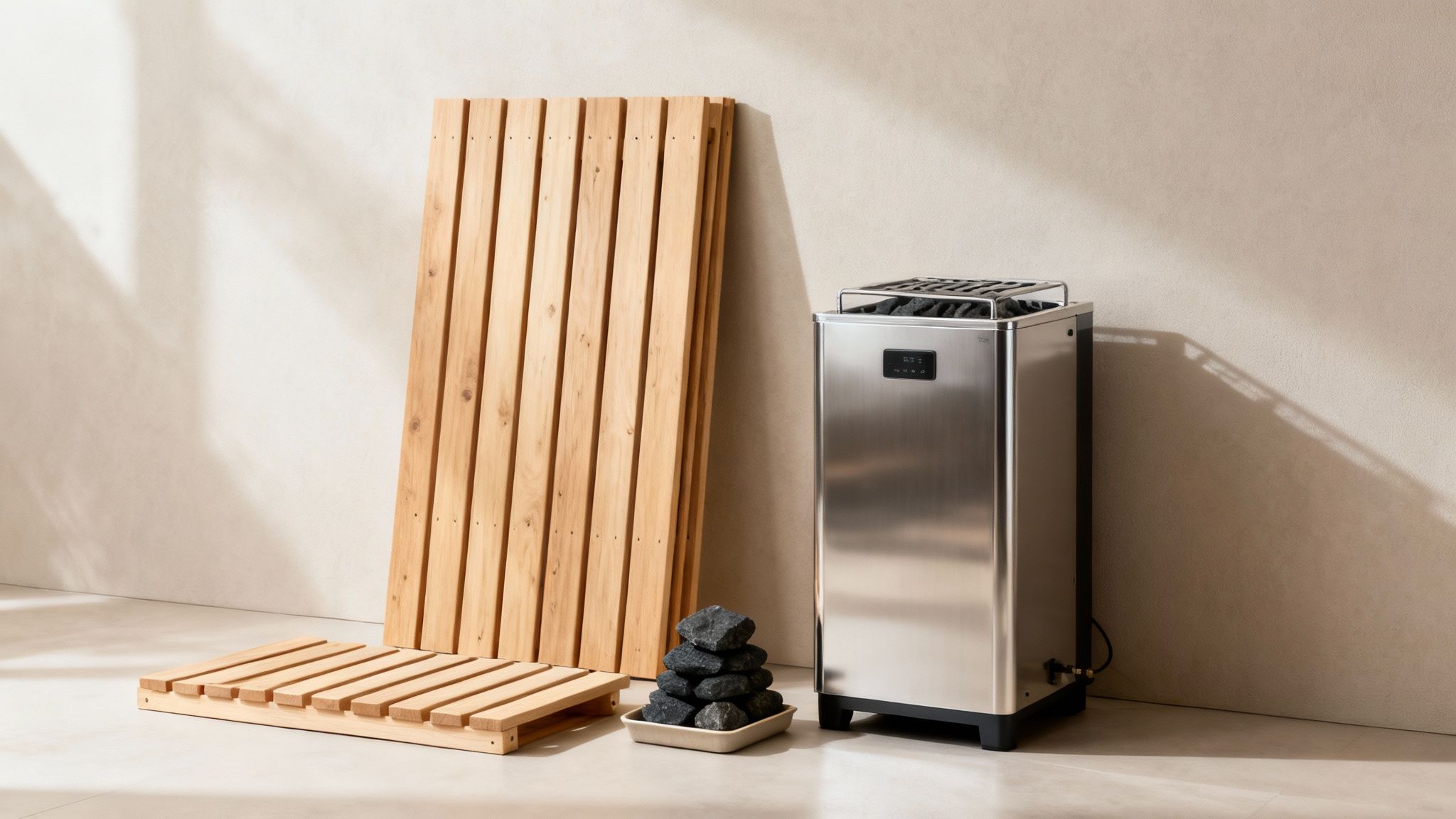
The sauna kit itself is the heart of your investment, so you really need to know what you’re getting for your money. It's tempting to go for the lowest price, but that almost always means cutting corners on materials and construction, which can lead to a flimsy, disappointing sauna that just doesn't last. The total cost of installing a sauna is fundamentally linked to the quality of the kit you start with.
When you invest in a premium kit, you're not just buying a box of wood panels. You're getting a complete wellness system, carefully engineered for safety, durability, and a top-notch experience. This is where you'll see the massive difference between a well-made sauna that ships within the USA and a cheaper, lower-quality import.
The Foundation: Premium Wood Selection
The type of wood used is easily the biggest factor in both the price and the overall quality of your sauna. You need high-grade wood for a simple reason: it has to handle constant, extreme changes in temperature and humidity without warping, cracking, or seeping unpleasant resins.
- Cedar: This is the classic, premium choice. Cedar is naturally tough against moisture and decay, gives off that amazing, distinct sauna aroma, and stays comfortably cooler to the touch.
- Hemlock: A fantastic, scent-free alternative known for its durability and consistent color. Hemlock is a strong, dense wood that insulates incredibly well and resists splintering.
Choosing the right wood isn't just a matter of preference; it's about performance. In fact, the global sauna components market is now worth around USD 869 million, largely because people are demanding these high-quality, heat-resistant woods. You can read more about the growth drivers of the sauna components market to see why these superior materials are so critical. They're a bigger part of the cost, but they are absolutely essential to the sauna's structural integrity.
The Heart of the Sauna: The Heater
Think of your sauna's heater as its engine. It's the powerhouse that creates that perfect, therapeutic heat. A reliable, well-built heater is non-negotiable for consistent temperatures and, most importantly, safe operation. The three main types come with different price tags and benefits:
- Electric Heaters: By far the most common choice for home saunas. They're convenient, easy to use, and give you precise control over the temperature.
- Wood-Burning Stoves: These offer that authentic, rustic, off-grid experience. They're a perfect fit for outdoor saunas where you want a more traditional feel.
- Infrared Heaters: Instead of heating the air, these use infrared light to heat your body directly. They run at lower temperatures and are often praised for their energy efficiency. To see if this is the right fit, you can explore our guide to the best infrared saunas.
A superior heater doesn't just work better—it saves you money. It heats up faster and holds its temperature more efficiently, which means lower electricity bills over the years. It’s a classic case of paying a bit more upfront for a much better performance and lower running costs down the road.
Included Accessories and Support
Finally, a good kit doesn't stop with wood and a heater. It includes all the thoughtful details that make the experience complete, like comfortable backrests, proper flooring, and good lighting. Just as important, it comes with crystal-clear assembly instructions and real customer support you can actually reach.
This is why choosing a trusted brand like Mande Spa Outdoor can make all the difference. Their saunas ship within the USA, so you know you're not getting a lower-quality import. With Mande, you’re getting premium materials, solid construction, and dedicated support that guarantees a safe, durable, and truly relaxing sauna for years to come. Don't settle for less; explore their collection and purchase a sauna that's a true investment in your long-term wellness.
Unpacking Labor and Professional Installation Costs
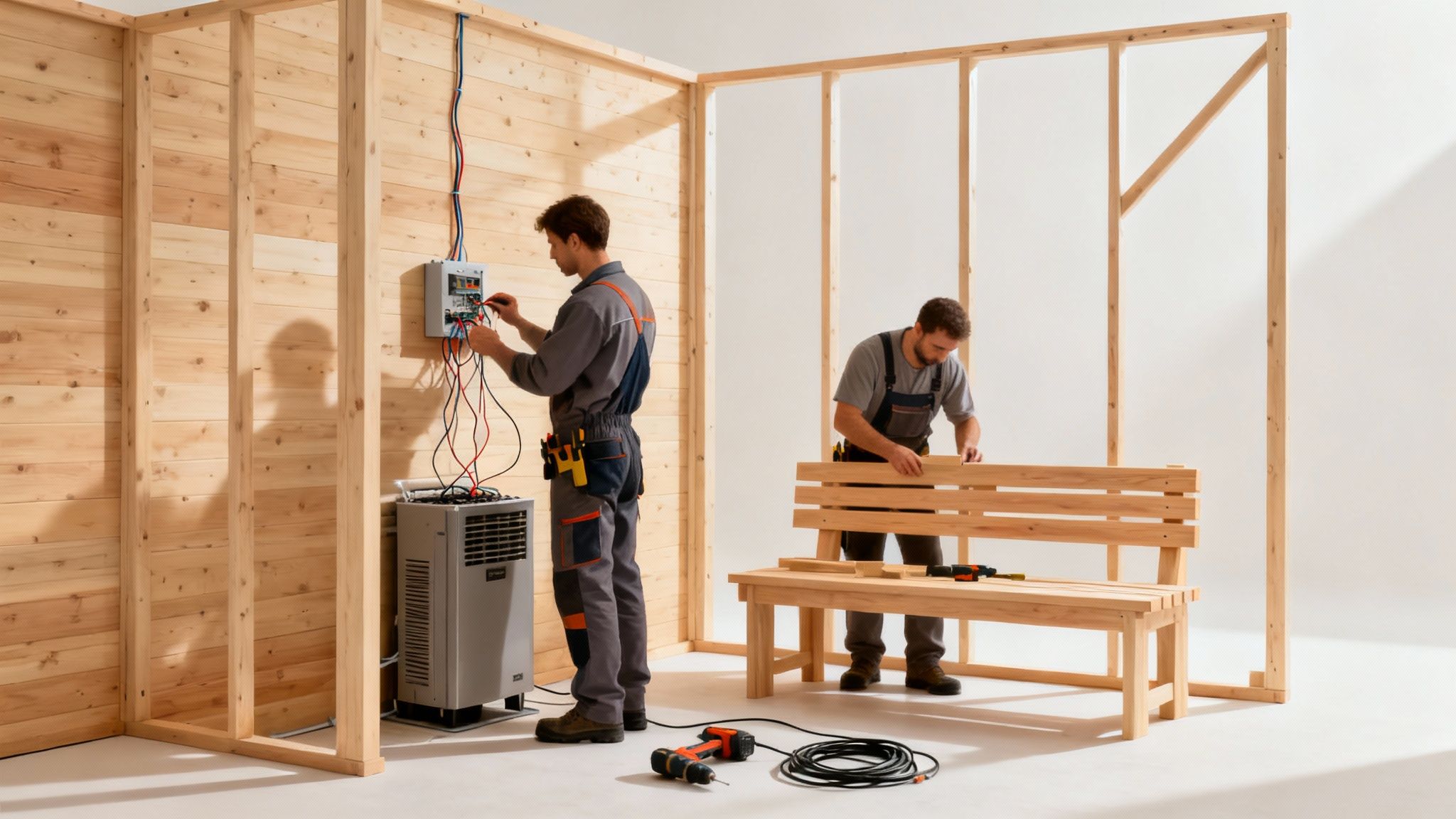
Alright, you've got your sauna picked out. Now comes the big question that every homeowner faces: Do you roll up your sleeves and build it yourself, or do you call in the pros?
This is a classic crossroads, and the path you take will make a huge difference in your final budget. There's no single right answer, just the one that’s right for you.
The DIY Approach: Savings and Satisfaction
For the hands-on homeowner, building your own sauna is more than just a way to save money—it’s a genuinely rewarding project. The key to a successful DIY build is starting with a great kit. This is where a high-quality brand like Mande Spa Outdoor really shines, as their saunas ship within the USA and are designed for straightforward assembly.
Their kits come with precision-cut panels and clear, easy-to-follow instructions. You won't be scratching your head trying to decipher confusing diagrams from a lower-quality import.
That said, you’ll need some basic skills. If you're comfortable with measuring, leveling, and general carpentry, you're in a good spot. But here's one part you can't skip: the electrical work. Wiring the heater is not a DIY task. For safety and to meet building codes, this job must be handled by a licensed electrician.
The Professional Installation Route: Peace of Mind
Let's be honest, sometimes you just want it done right without the hassle. If that sounds like you, hiring professionals is the way to go. It takes all the guesswork out of the equation and guarantees a perfect finish, but you'll need to account for it in your budget.
What you'll pay depends a lot on where you live and how complex the job is. Here’s a look at the team you might need to bring in:
- General Contractor or Carpenter: This is the person who will assemble the sauna kit and handle any custom finishing touches. Their rates typically fall between $50 to $150 per hour. A standard prefab kit usually takes about 4-8 hours to assemble, so you're looking at $200 to $1,200 for the build.
- Licensed Electrician: As mentioned, this is a must. They'll run a dedicated circuit and wire the heater safely. Electricians generally charge $75 to $150 per hour, and the job often takes 3-5 hours, putting the cost between $225 and $750.
Ultimately, the decision comes down to a simple trade-off: your budget versus your time and skill. Going the DIY route can save you a bundle, but professional installation offers expertise and pure convenience.
Making the Right Choice for Your Budget
So, how do you decide? A DIY installation can easily save you $1,000 or more, but it's an investment of your own time and sweat. If you're leaning that way, our guide on how to make a sauna at home is a great resource to see what’s involved.
On the flip side, hiring a pro ensures the job is done perfectly from the start, avoiding any frustrating and potentially costly mistakes down the line.
When you start with a premium sauna from Mande Spa Outdoor, you're already beginning with a top-tier product shipped right here in the USA. Whether you build it yourself or hire an expert, you’re on the path to an incredible wellness experience. We strongly encourage you to see the Mande Spa Outdoor collection for yourself.
Getting Your Space Sauna-Ready
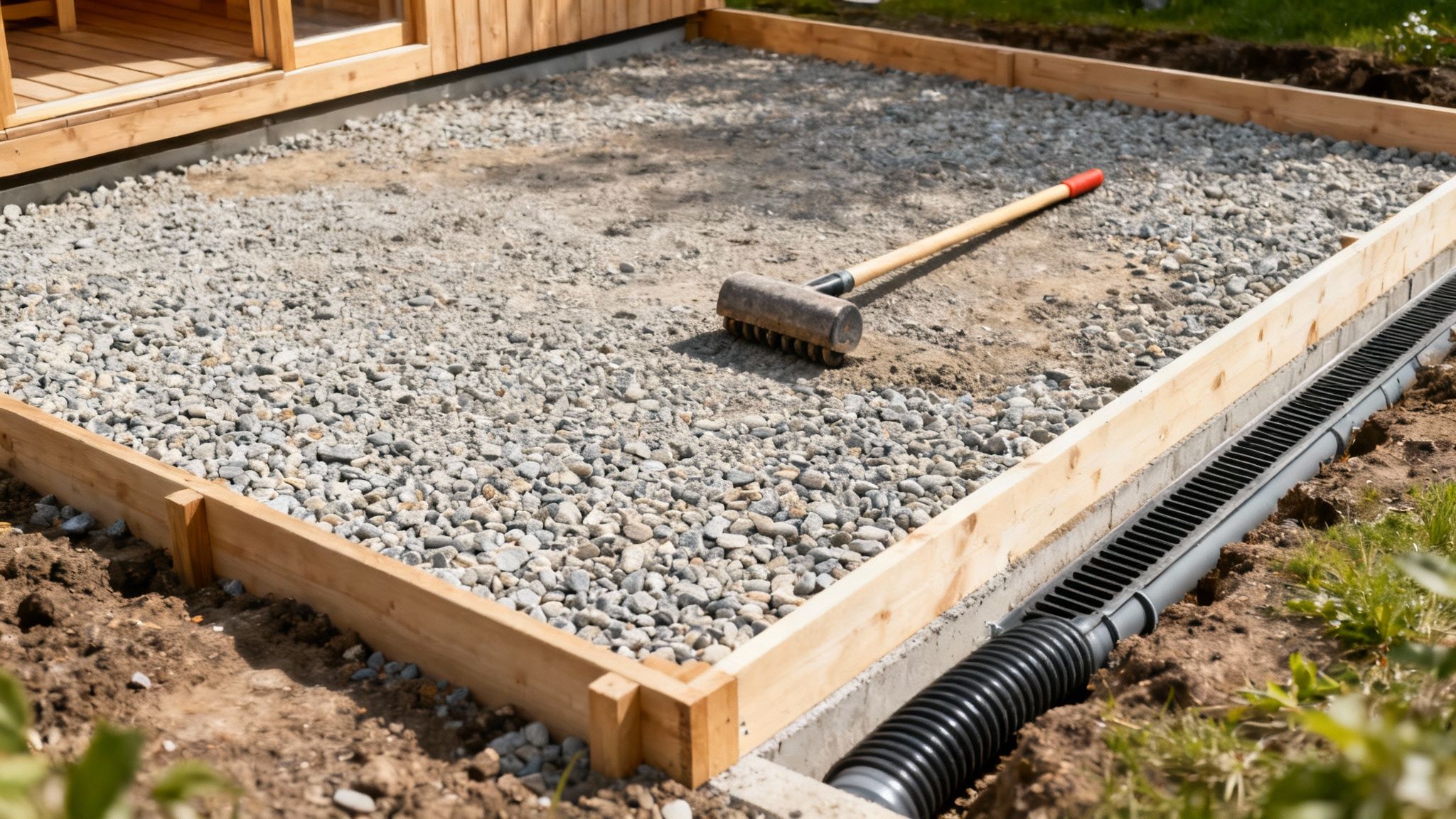
Before you can even think about that first blissful sweat session, you have to give your sauna a proper home. Whether you're tucking it into a corner of your basement or making it a backyard centerpiece, the spot you choose dramatically influences the final cost of installing a sauna.
These initial site prep expenses are the ones people often forget, but they're absolutely critical for a safe, durable, and long-lasting wellness retreat. Think of it like building a house—you wouldn't start framing on a shaky foundation, right? The same logic applies here. Getting the groundwork right protects your investment and ensures your sauna performs flawlessly for years.
Building a Solid Outdoor Foundation
If you’re dreaming of an outdoor sauna, the first and most critical step is creating a perfectly level and solid base. Just plopping a sauna down on grass or uneven dirt is a recipe for disaster; you'll end up with an unstable structure and potential damage down the road.
You’ve got a few solid options for a sturdy foundation:
- Concrete Slab: This is the gold standard for a reason. It's permanent, stable, and built to last. Expect to pay around $5 to $10 per square foot, which means a small pad might run you $400 to $800.
- Paver Patio: Another fantastic and often more visually appealing choice that also provides excellent drainage.
- Gravel Base: Looking for a budget-friendly route? A simple, well-compacted gravel pad can often be done for just $200 to $500.
- Wooden Deck: If you have a deck already, great! Just make absolutely sure it can handle the sauna's substantial weight. You may need to add reinforcements.
Proper site prep is everything for an outdoor build. For a deeper dive, check out our complete guide on building an outdoor sauna.
Preparing Your Indoor Sauna Space
Indoor saunas come with their own checklist. While you can skip pouring a concrete pad, you absolutely have to tackle ventilation, drainage, and flooring to head off any moisture problems.
The right floor is non-negotiable. You need a waterproof surface like concrete, tile, or vinyl. Please, do not install a sauna on carpet—it’s a surefire way to trap moisture and invite mold.
One of the most important factors for both safety and your budget is a dedicated electrical circuit. Most sauna heaters are power-hungry and need a 240V connection, which is a job for a licensed electrician. This isn't just a suggestion; it's essential for preventing overloads on your home's electrical system.
This crucial electrical work typically costs between $225 and $750. It’s a line item you can't afford to skip, as it guarantees your sauna is both safe and up to code. When you’re ready to bring this amazing wellness experience home, invest in a quality unit and get the installation right from the ground up.
Beyond the Build: Understanding Your Sauna's Long-Term Costs
The day your sauna installation is complete is a fantastic milestone, but it's not the end of the story when it comes to your investment. Just like a car needs gas and the occasional oil change, your sauna has ongoing operating costs. Thinking about these ahead of time is what separates a smart purchase from one that brings surprise bills down the road.
Honestly, the biggest line item you'll see month-to-month is the energy needed to power your heater. How much this actually adds to your utility bill really boils down to the kind of heater you've got and, of course, how often you’re firing it up for a good sweat session.
Breaking Down Energy Consumption
Think of your sauna heater like you would any other major appliance. The specifics matter. A more powerful heater will naturally draw more electricity, but it might also get your sauna up to temperature much faster, which can sometimes even out the cost.
Here’s a quick look at the common options:
- Electric Heaters: These are the crowd favorite for a reason. A standard 6kW electric heater, if you're using it about three times a week, will likely add somewhere between $15 to $40 to your monthly power bill.
- Infrared Heaters: If you're looking for peak efficiency, this is usually your best bet. Infrared panels heat your body directly instead of the entire room, so they get the job done with less power. That often translates to lower running costs.
- Wood-Burning Stoves: Here, you're trading an electricity bill for a firewood bill. There's no electric cost, but you will need to factor in the price of sourcing a steady supply of good, dry firewood.
There’s a reason saunas weren't always a common household feature. The high energy use and maintenance of older, traditional models created a real hurdle for many families. The need for special ventilation, dedicated power lines, and thirsty equipment just wasn't practical. You can dig deeper into some of the market trends and financial barriers in the sauna industry that shaped today's landscape.
A Little Maintenance Goes a Long Way
Aside from the energy costs, you’ll want to perform some simple, routine care to keep your sauna feeling fresh and new for years. The good news? A well-built sauna doesn't ask for much. We're talking about basic things like wiping down the benches after you're done, giving the interior a gentle clean with a sauna-safe product every so often, and checking that your heater stones are stacked correctly.
The initial quality of your sauna directly impacts its long-term maintenance costs. Choosing a durable, well-engineered model from the start minimizes future repair bills and ensures a consistently excellent experience.
This is exactly why we're so passionate about the saunas from Mande Spa Outdoor. Many lower-quality imports cut corners with inferior wood or unreliable heaters that just don't stand the test of time. Their saunas, however, ship within the USA and are designed for maximum durability and efficiency.
When you invest in a quality unit, you're not just buying a hot room; you're securing a low-maintenance wellness retreat for your home. Purchase a sauna that's built to last and enjoy the peace of mind that comes with making a smart, long-term choice for your health and your wallet. We encourage you to visit the Mande Spa Outdoor website to see the difference.
Ready to Bring the Spa Home?
So, there you have it—a complete breakdown of what it really costs to install a sauna, from the initial purchase right down to the long-term care. You're now equipped with the details you need to move forward confidently and make a smart investment in your personal health and relaxation. A home sauna is so much more than a luxury; it's a real commitment to your well-being.
When you're ready to make that leap, I can't stress enough how important it is to prioritize quality. This is exactly why we stand behind the premium collections from Mande Spa Outdoor. Honestly, it's just not worth the headache to roll the dice on lower-quality imports that often show up with hidden problems and customer service that’s nowhere to be found when you need it.
Go for Quality and Real Support
What makes Mande Spa Outdoor different is their dedication to building saunas that last, all shipped directly from here in the USA. Their focus on excellence means you’re getting a product engineered for a smooth assembly, and it’s all backed by a support team you can actually get on the phone. That kind of quality and service is what protects your investment for the long haul.
Investing in a home sauna is an investment in yourself. Choosing a trusted brand like Mande Spa Outdoor that ships within the USA ensures that your wellness journey starts on a foundation of quality, durability, and peace of mind.
That personal wellness sanctuary you've been dreaming about is a lot closer than you think. You deserve the best for your home and your health, so don't settle for less.
It’s time to stop just thinking about it and start relaxing. Purchase a sauna that promises countless hours of rejuvenation and will quickly become the heart of your home wellness routine. Take a look at the exceptional Mande Spa Outdoor collection today and find the perfect model to start your journey. Your ultimate escape is just a click away.
Got Questions About Sauna Installation Costs? We've Got Answers
Even with all the numbers laid out, you probably still have a few lingering questions. That's perfectly normal. Getting these last few details ironed out is often the final step before you can confidently decide to bring this incredible wellness tool into your home.
Let's dive into some of the most common questions we hear from people just like you.
Can I Just Install a Sauna Myself to Save Some Cash?
You absolutely can, and it's one of the best ways to slash the total project cost. Many of today's best sauna kits are engineered specifically for DIY assembly, meaning you can save anywhere from a few hundred to several thousand dollars on professional labor. It's a satisfying project for anyone who's a little handy.
But there's one part of the job you should never, ever do yourself: wiring the heater. This is where you bring in a licensed electrician. It's a non-negotiable safety step that guarantees everything is up to code and running safely. You build the sanctuary; let a pro handle the high-voltage part.
So, How Much Is This Going to Add to My Monthly Electric Bill?
This is a big one for a lot of people, but the answer is usually a pleasant surprise. The monthly cost to run your sauna is often far less than you'd think. It really just boils down to your heater's power (wattage), how often you escape into your sauna, and what you pay for electricity in your area.
Let's put some numbers on it. A standard 6kW electric heater, used for an hour about three times a week, will likely only add between $15 and $40 to your monthly utility bill. Infrared models are even more efficient and can cost even less. When you stack that up against what you'd pay for a single spa visit, a home sauna quickly becomes an incredibly affordable luxury.
Is an Outdoor Sauna More Expensive to Install Than an Indoor One?
This is a great question, and the answer is a bit of a "yes and no." The final installation costs tend to be pretty similar, but the money goes to different things depending on where you put it.
For an outdoor sauna, your biggest extra expense is almost always the foundation. You'll need a solid, level base like a concrete slab, a paver patio, or a reinforced deck, and that can add a hefty sum to the budget.
On the other hand, an indoor sauna doesn't need a foundation, but you might need to spend on other things. Think about proper ventilation, installing a vapor barrier to protect your walls, or putting in waterproof flooring. In the end, the choice between indoor and outdoor usually comes down to space and lifestyle, not a huge difference in the price tag.
Investing in a high-quality sauna from Mande Spa Outdoor is the surest way to get a smooth installation and keep your long-term costs down. Their saunas ship right here in the USA, so you know you're not getting a lower-quality import. It's time to bring that wellness sanctuary home and purchase a sauna today.
Explore the Mande Spa Outdoor collection and find the perfect sauna that will deliver relaxation and health benefits for years to come.